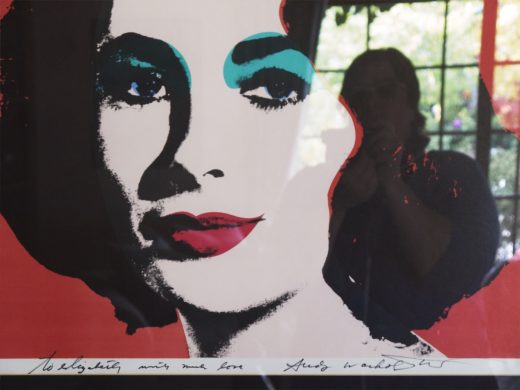- Midnight Thrift

- A New Day Has Come: A Review of Radical Hope: Letters of Love and Dissent in Dangerous Times
Catherine Opie: 700 Nimes Road
Erica Ando
 Catherine Opie, Andy Warhol to Elizabeth (Self-Portrait Artist) from the 700 Nimes Road portfolio, 2010–11. Pigment print, 16.5 x 22 inches. Courtesy the artist, Regen Projects, Los Angeles, and Lehmann Maupin, New York and Hong Kong
Catherine Opie, Andy Warhol to Elizabeth (Self-Portrait Artist) from the 700 Nimes Road portfolio, 2010–11. Pigment print, 16.5 x 22 inches. Courtesy the artist, Regen Projects, Los Angeles, and Lehmann Maupin, New York and Hong Kong
NSU Art Museum Fort Lauderdale
February 12–June 18, 2017
One of the first photographs in Catherine Opie’s 700 Nimes Road depicts the iconic Andy Warhol screenprint of the actress Elizabeth Taylor. The supersaturated colors of the print dominate the left side of the photograph. An inscription, “to elizabeth with much love Andy Warhol,” along with the intimation of a flowering garden and Opie’s silhouette in the reflective glass, tell us that the image was taken in a specific location, at Taylor’s Bel Air home. Titled Andy Warhol to Elizabeth (Self-Portrait Artist) (2010–11), Opie’s photograph is both portrait and self-portrait, and an acknowledgement of the inherent challenges in representing the movie star. The exhibition, named after the address of the actress’ home, comprises fifty photographs created throughout a period of six months in 2010 and 2011, during which time the 79-year-old Taylor died.
On the face of it, Taylor and Opie could not be more different. Taylor’s very public, glamorous life was an object of fascination in the press, which fixated on her multiple marriages, ultrafeminine jewelry, and designer clothing. In contrast, Opie became known in the early 1990s for her portraits of the L.A. leather-dyke community of which she was a member. Her self-portraits of that time still possess shock value: in one, a shirtless Opie sits facing the camera, her head encased in a black leather hood and the word “pervert” carved into the skin across her chest, while neat rows of needles pierce her arms. Throughout her career, however, her reimaging of stereotypes and icons have included not only sexually marginalized communities, but also high school football players and surfers, sunsets, highways, and cityscapes, making her a strangely fitting choice to depict the aging star.
Opie was inspired by William Eggleston’s 1983 portrait of Graceland, Elvis Presley’s home. Photographing Taylor’s home, she paid close attention to the effects of sunlight at different times of the day, imbuing the images with a sense of narrative. Apart from a handful of full-room shots, the majority of the photographs are close-ups of objects—rows of handbags organized by color; arrays of tchotchkes and family photos that reveal themselves to include Taylor’s three Oscar Awards and photos of her with Michael Jackson, Bill and Hilary Clinton, and Queen Elizabeth; and clothing—silky, velvety, and brocaded. Rather than attempting to dispel the glamour and femininity in the objects and their owner, Opie finds their humanness. Shooting the objects at arm’s reach or at an angle suggestive of the moment before we were to touch something and put it to use, Opie contemplates on the meanings we impart to things.
Taylor’s unexpected death in the middle of the project transformed the series from a portrait to a remembrance. An air of reverence pervades the images, as if Taylor’s communion with her things evaporated suddenly, while Opie achieves a quiet quality in the photographs through her meditative perspective, allowing viewers to feel intimacy rather than voyeurism.
Erica Ando is an art writer and an assistant curator at the Norton Museum of Art, West Palm Beach.








